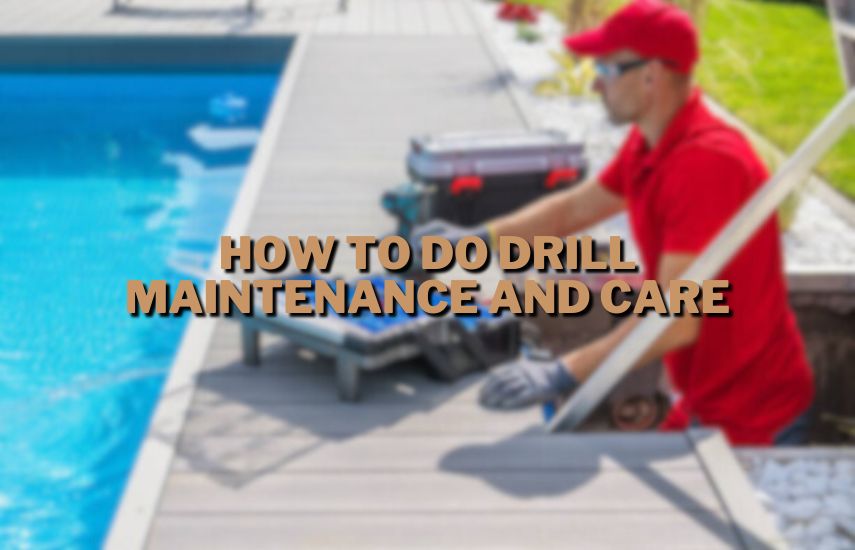Welcome to the world of DIY enthusiasts! Whether you’re a newbie or a seasoned DIYer, knowing how to properly maintain and care for your drill is essential. Your trusty drill is a versatile tool that helps you accomplish a wide range of tasks, from simple household fixes to more complex projects. In this guide, we’ll walk you through the steps of drill maintenance and care, ensuring that your tool remains in tip-top shape whenever you need it.
How To Do Drill Maintenance And Care? Maintaining and caring for your drill is crucial for its longevity and optimal performance. After each use, wipe down the exterior with a clean cloth. Regularly check the power cord for any signs of damage. Keep the chuck area clean and lubricated with appropriate oil. Store in a dry place.
Regular maintenance not only prolongs the lifespan of your drill but also ensures its efficiency and safety during use. From cleaning to lubricating, we’ll cover the basics of keeping your drill in excellent working condition. So, let’s dive into the world of drill care – a few simple steps that go a long way in making your DIY endeavors smooth and hassle-free.
Essential Drill Care Tips
Drills are handy tools that help you with various tasks, but they need some care to keep performing at their best. Regular maintenance can extend their lifespan and improve their efficiency.
Cleaning After Use
After each use, take a few minutes to clean your drill. Wipe off any dust, debris, or wood/metal shavings. Use a soft cloth or a brush to get into the crevices. Keeping your drill clean prevents buildup that can affect its performance.
Lubrication for Smooth Operation
Proper lubrication is crucial for the smooth operation of your drill. Refer to the manufacturer’s guidelines for the appropriate lubricant and frequency. Apply lubricant to moving parts like gears and chuck to prevent friction and wear.
Checking and Tightening Parts
Regularly inspect your drill’s components for any loose or damaged parts. Gently tighten any screws or bolts that may have come loose due to vibrations. Replace any worn-out parts to avoid potential hazards during operation.
Proper Storage
When not in use, store your drill in a dry and clean area. Keep it away from direct sunlight, extreme temperatures, and moisture. Storing it in its original case or a dedicated storage box can protect it from dust and potential damage.
Battery Maintenance
If your drill is cordless, taking care of its battery is essential. Avoid overcharging by unplugging it once fully charged. If the drill will not be used for an extended period, partially charge the battery before storing it. This helps prevent battery degradation.
The Art of Caring for Your Drill

Caring for your drill is more art than science, a dance of practicality that keeps your tool in its prime. Delve into the world of drill maintenance and discover the finesse behind it.
Embrace the Basics
Imagine your drill as an awaiting canvas for your creative touch. Nurturing its well-being means embracing the fundamental aspects. A successful blend of knowledge and hands-on experience forms the essence of mastering its care. Just as an artist learns the basics of their craft, delving into the essentials of drill maintenance ensures optimal performance and longevity.
Clear the Canvas
In the aftermath of each drilling project, take a cue from painters and clear your drill’s canvas. Just as a painter brushes away excess paint, sweep off dust, wood chips, or metal scraps that may cling to your tool. This straightforward action ensures a pristine starting point for your next creative undertaking.
Strengthen the Framework
Envision your tool as a work of art, requiring a sturdy framework. Much like a painter fortifies the canvas before creating a masterpiece, you should regularly examine your drill for any signs of loose screws or bolts, particularly after it has been put to the test with demanding tasks.
The act of tightening these integral components is comparable to bolstering the very foundation of your artwork, contributing to its overall stability and long-lasting endurance. By dedicating attention to this foundational aspect of care, you ensure that your drill remains reliable and steadfast, prepared to assist you effectively in various tasks for years to come.
A Sheltered Masterpiece
Your drill is a masterpiece in its own right, deserving of a protective cover. Store it in a secure, dry place away from extreme conditions, similar to shielding a delicate sculpture from the elements. The right storage preserves its aesthetic and function.
Nurture the Source
For cordless drills, the battery is the wellspring of energy. Treat it as you would a prized element in your creation. Avoid overcharging by disconnecting when fully charged. Before storing it, give the battery a gentle boost, akin to replenishing a muse’s inspiration.
Troubleshooting common drill problems
There are a few common drill problems that you may encounter. Here are some tips on how to troubleshoot them:
Drill not turning on
Check the power cord to make sure it is plugged in and turned on. Check the battery if your drill is cordless. Make sure the switch is in the “on” position. If the drill still does not turn on, it may be a problem with the motor. In this case, you should take the drill to a qualified repair technician.
Drill not drilling straight
Make sure the drill bit is sharp and properly inserted into the chuck. Use a drill guide to help you drill straight. If the drill bit is still not drilling straight, it may be a problem with the chuck. Then, you should take the drill to a qualified repair technician.
Drill smoking
This is usually caused by overheating. Stop using the drill and let it cool down. Make sure you are using the drill at the correct speed for the material you are drilling. If the drill is still smoking after it has cooled down, it may be a problem with the motor. In this case, you should take the drill to a qualified repair technician.
Drill bit gets stuck
This is usually caused by using too much force. Reduce the amount of force you are using and try again. You can also try tapping the drill bit with a hammer to loosen it.
Drill bit breaks
This is usually caused by using the wrong drill bit for the material you are drilling. Make sure you are using the correct type of drill bit for the job. You can also try using a slower speed or applying less force.
If you are having trouble troubleshooting a drill problem, you can always consult the owner’s manual or contact the manufacturer for help.
Conclusion (How To Do Drill Maintenance And Care)
Keeping your drill in great shape is easy. After every use, clean off dust and debris with a cloth or brush. Lubricate moving parts for smooth operation. Check and tighten any loose parts. Store it in a dry place, away from extreme conditions. For cordless drills, charge the battery smartly. Simple steps that ensure a reliable and lasting tool.
In the world of DIY, your drill is a trusted companion. By now, you’ve uncovered the art of its maintenance—a symphony of cleaning, lubricating, and inspecting. These simple steps, much like tending to a cherished garden, ensure your drill’s longevity and precision.
As you wipe away debris, nurture its components, and protect it in storage, you’re crafting a tale of dedication. Your drill, a tool of creation, rewards your care with consistent performance. Remember, in the realm of maintenance, you’re the conductor, guiding your tool towards a harmonious and enduring partnership.
FREQUENTLY ASKED QUESTIONS
Caring for your hand drill?
To care for your hand drill, start by cleaning it after each use. Wipe off dust and debris with a soft cloth or brush. Then, lubricate the moving parts for smooth functioning. Check for loose parts and tighten them if needed. Store the drill in a dry place away from extreme conditions. For cordless drills, manage the battery by charging it properly. Following these steps keeps your hand drill in great shape.
Maintenance needs of a drill?
Drills need regular maintenance to perform well. This includes cleaning after each use to prevent debris buildup. Lubricating moving parts ensures they work smoothly. Checking and tightening loose parts prevents malfunctions. Storing the drill in a dry place and managing the battery for cordless drills are essential. Maintenance keeps your drill reliable and ready for tasks.
Six steps for using a drill?
Using a drill involves six simple steps. First, choose the right drill bit for your task. Then, secure the material you’re drilling. Adjust the drill’s speed and direction according to your needs. Hold the drill steadily and start drilling slowly. Apply consistent pressure and avoid pushing too hard. Finally, release the trigger before lifting the drill from the hole. Following these steps ensures effective and safe drilling.
Understanding the 4 Stages of drill?
Drilling involves four main stages. The first is “Positioning,” where you place the drill correctly on the material. Then comes “Starting,” where you gently begin drilling to create a small dent or guide hole. After that is “Pecking,” where you drill in short bursts to avoid overheating. Lastly, “Finishing” involves drilling through the material steadily and carefully. These stages ensure efficient and precise drilling.
Breaking bown the 5 parts of a drill?
A drill has five key parts. The “Chuck” holds the drill bit in place. The “Trigger” controls the drill’s speed. The “Handle” provides a grip for stability. The “Body” houses the drill’s motor and components. The “Battery” powers cordless drills. Understanding these parts helps you use the drill effectively and perform maintenance when needed.









